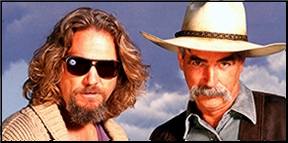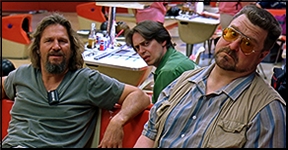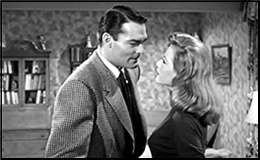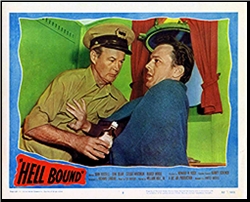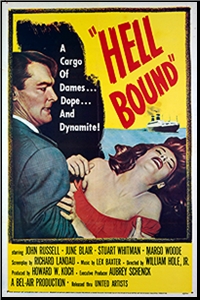FIRST YOU READ, THEN YOU WRITE
by Francis M. Nevins

For reasons which will become clear about halfway through this column, my subject this month is David Goodis. Most of you who are reading this probably know a little about the man, but for the benefit of those who need their recollections refreshed, I’ll begin with a brief sketch of Goodis and his world.
He was born in Philadelphia on March 2, 1917 and, except for a few years in Hollywood, spent most of his life there. Soon after graduating from Temple University he broke into print with RETREAT FROM OBLIVION (1939), a mainstream novel that made zero impact at the time and hasn’t been reprinted since.
Rejected for military service in World War II, he spent the war years cranking out an estimated five and a half million words for Battle Birds and a slew of other pulp magazines, mainly tales of air combat with titles like “Death Flies the Coffins of Hitler,†“Death Rides My Cockpit†and “Guns of the Sea Raiders.â€

Almost none of this material has been reprinted either, and probably never will be. His greatest commercial success was his second novel, DARK PASSAGE (1946), a noir thriller about an innocent man convicted of his wife’s murder who escapes from San Quentin, has plastic surgery performed on his face and begins a hunt for the real killer.
The Saturday Evening Post paid Goodis a huge sum for the right to serialize the book before its hardcover release, which inspired rave reviews including one from Anthony Boucher in the San Francisco Chronicle (October 20, 1946): “[H]ere is the most notable talent to emerge in the field in a long time. Mr. Goodis has an originality of naturalism, a precise feeling for petty lives, a creatively compelling vividness of detail….This is the goods.â€
Very little time passed before Warner Bros. paid Goodis another huge sum of money for the movie rights. DARK PASSAGE (1947) was an excellent film noir directed by Delmer Daves and starring Humphrey Bogart and Lauren Bacall. Warners offered Goodis a screenwriting contract, but the results were disappointing from both his and the studio’s point of view. In 1950 he returned to Philadelphia and his parents’ house and reinvented himself as a writer of paperback originals.

The style of DARK PASSAGE and his other novels of the late Forties evoked the naturalism of authors like Hemingway, but his initial impact on suspense fiction approximated that of Cornell Woolrich. Stylistically his paperbacks resembled his hardcovers except that a vital element had been discarded. What makes Woolrich the Hitchcock of the written word is his uncanny genius for making us feel the terror and uncertainty of his menaced protagonists. But we can’t experience true terror or uncertainty unless the outcome is genuinely in doubt, and in fact we can’t tell until the climax of a Woolrich novel or story whether it’s allègre or noir, whether the characters whose nightmares we share will be saved or destroyed.

In Goodis’s paperbacks, however, there is no basis for even a moment’s hope and thus no real suspense. His people are born losers and victims who try to cheat their fate by living as zombies, shunning all involvement with others and the world, sustained by booze, cigarettes and mechanical sex. What they learn is that there’s no way out of the trap they’re in. Whatever they do or don’t do, life is going to get them.
Character types, settings and motifs recur in his paperbacks with ritualistic frequency. A run-down old house in a seedy district of Philadelphia. A loud corner tavern, filled at all hours of the night with smoke and sweat, gin fumes and derelicts beyond hope. The docks, with at least one graphically described fistfight every time Goodis takes us there. A frightened, friendless, lonely man, living in the night. A fat sadistic woman, oozing grotesque sexuality. A brilliant creative person defeated by the world so badly that he’s reduced to a passive drunken wisp, muttering mournfully of meaninglessness. Bizarre little philosophic conversations between total strangers. Beaten protagonists dully resuming zombie lives as the novels end.

It’s typical of Goodis’ world that in THE MOON IN THE GUTTER (Gold Medal pb #348, 1953) the viewpoint character Kerrigan lets go free the parolee whom his wife hired to beat him to death, gives up hunting for the man who raped his sister and caused her suicide, and goes back to live with his vicious wife.
Or take that gem of noir BLACK FRIDAY (Lion pb #224, 1954). “January cold came in from two rivers, formed four walls around Hart and closed in on him.†The chilly hell that envelops Goodis’s luckless man-on-the-run from this first sentence only becomes more hellish as he stumbles upon a man shot to death in the street, gets away with a wallet containing $12,000 and winds up in a house on the northwest edge of Philadelphia and with, as in Sartre’s play, no exit.
For housemates he has a beautiful young woman, a fat blonde whore (who has counterparts in other Goodis novels) and four psychotic criminals. When the novel ends, the poor schmuck in whose shoes Goodis has made us live is unspeakably worse off than when it began. “He had no idea where he was going and didn’t care.â€
Soon after the death of his parents with whom he’d lived since his return from Hollywood, Goodis himself died, on January 7, 1967, less than two months before his 50th birthday.

Goodis, like Poe and Hitchcock and many others, owes a great deal of his recognition as a major figure to the French. The only biography of him to date is GOODIS: LA VIE EN NOIR ET BLANC (Paris: Editions du Seuil, 1984) by Philippe Garnier, who took great pains to interview everyone he could find who knew that haunted man.
Although I and many others tried unsuccessfully for years to find a U.S. publisher for this book, it was no thanks to me that almost thirty years after its original publication some brave soul made the commitment. GOODIS: A LIFE IN BLACK AND WHITE (Black Pool Productions, 2013) is required reading for anyone who loves Goodis but is not at home in French.
Until quite recently there was no book exploring the Goodis world, not even in French, but now we have Jay A. Gertzman’s PULP ACCORDING TO DAVID GOODIS (Down & Out Books, 2018). Gertzman, a retired professor of literature who knows Philadelphia very well indeed, doesn’t take us through the Goodis novels chronologically and developmentally — mainly, I suppose, because there are so many family resemblances among them — but opts to cover the history and sociology of the rundown Philly communities that Goodis before him knew just as well, and stresses his connections with literary and cultural icons like Hemingway, Faulkner, Freud and, first and foremost, Kafka. (The title of one of his chapters is “The Pulp Kafka of Philadelphia.â€)
Other approaches are possible, and I hope I live to see at least a few of them, but to Gertzman belongs the honor that with respect to Woolrich is mine. He was there first.

